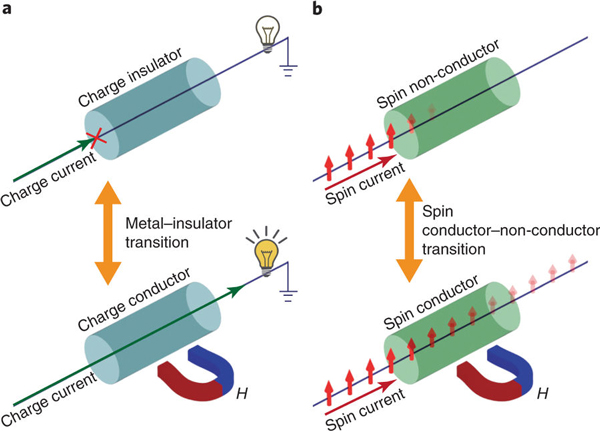Abstract
Spintronics is a research to realize devices using not only the charge of electrons but also the spin of electrons. We have witnessed the fruits of the research as ultra-high density hard disk drives and non-volatile memories and the journey to develop the spintronics devices are still on going.
Essential technologies in the spintronics is generation, detection, and control of spin current, a flow of spin in materials. Surprisingly, materials have built-in-mechanism to enable us to electrically detect the spin current: inverse spin hall effect (ISHE). Using the ISHE, spin current generated by other form of energies like microwaves (spin pumping) and heat (spin Seebeck effect) is transformed into electrical voltage in the material. Although the generation and the detection of the spin current are now that somehow established techniques, a long missing component in the history of spintronics is a “spin current switch”, a counterpart of transistors in the electronics to control the flow of spins.
Zhiyong Qiu, Dazhi Hou, Eiji Saitoh, and collaborators at Tohoku University, have proved that a newly developed layered structure of materials works as the spin current switch. Using the found structure, they proved to control the transmission of spin current up to 500% near the room temperature.
The layered structure is a tri-layer sandwiching Cr2O3 by yttrium iron garnet (YIG) and platinum (Pt). The pair of YIG/Pt is a standard combination of materials to investigate the spin current flow. YIG, a ferrimagnet electric insulator, generates spin current in response to RF microwave or temperature gradient and Pt, a paramagnetic metal, detects the spin current as an electric voltage via ISHE. By sandwiching Cr2O3 therebetween, the voltage signal at Pt reflects how much Cr2O3 layer can transmit the spin current. The authors investigated the change of the voltage against the temperature and the applied magnetic field.
“We could observe a giant reduction in the voltage signal when crossing the temperature, about 300K, at which Cr2O3 changes its phase from paramagnet to anti-ferromagnet (Neel point).“, said Dazhi Hou. The change of the spin current transmission is about up to 500% under the application of magnetic field. The observed behavior suggests that the layered structure works as a spin current switch by crossing the Neel point of Cr2O3 or applying a magnetic field.
“The proven spin wave spin current switch may trigger a new direction of spintronics as the advent of transistor in electronics triggered scalable development of the electronics to the level of modern”, said Eiji Saitoh.
Publication Details
Title
Spin colossal magnetoresistance in an antiferromagnetic insulator
Authors
Zhiyong Qiu, Dazhi Hou, Joseph Barker, Kei Yamamoto, Olena Gomonay, Eiji Saitoh
Journal
DOI
Published online
28 May 2018 (UK)
Press release online
https://www.tohoku.ac.jp/en/press/breakthrough_for_spintronics.html

Fig. 1: Concept of Spin colossal magnetoresistance (SCMR) (From: Spin colossal magnetoresistance in an antiferromagnetic insulator)
